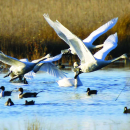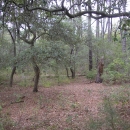Visit Us
Mackay Island NWR is perfect for nature photography, birding, hiking, biking, and wildlife observation, featuring concentrations of snow and Canada geese, ducks, warblers, osprey and other raptors, wading birds, and shorebirds, along with a variety of reptiles, amphibians and mammals.
Activities
The refuge is open from sunrise to sunset for a variety of activities, from hiking and bicycling to birding and wildlife photography. Bank fishing and boating are also popular on the refuge. The refuge offers special hunts during the fall for white-tailed deer and waterfowl.
All portions of the refuge are open to wildlife-dependent recreation from March 15 through October 15. Most of the refuge is closed to public access from October 16 through March 14 to reduce disturbance to wintering waterfowl. Mackay Island Road from NC 615 to the Dike Gate, the Great Marsh Loop Trail, the Kuralt Trail Overlook, and the Marsh Causeway are open year-round.
The road to the Visitor Contact Station and Hegge Impoundment Overlook is open 10am to 4pm Monday through Friday, contingent on staffing availability.
Special "Open Roads Day" events are held throughout the year where visitors may drive the dike and trail system around the refuge impoundments to view wildlife. These are publicized in advance through local media and on the Events page.
Roads throughout the refuge are graveled and visitors must maintain the posted speed limit of 15 miles per hour. Parking is allowed in designated parking areas only. No overnight parking is allowed on the refuge.
Insect repellent and sun screen are a must. Wear sneakers or comfortable walking shoes. Be aware that cottonmouth and other venomous reptiles call Mackay Island home.
Trails
The refuge has several trails, ranging from the short Great Marsh Trail loop to longer hikes like the Live Oak Point Trail. Walking or biking the refuge is a great opportunity to see wildlife, from otters and osprey to wood ducks and warblers.
The Live Oak Point Trail, West Pool Trail, and other dike roads around the impoundments are closed from October 16-March 14 to prevent disturbance to wintering waterfowl.
Related Documents
Other Facilities in the Complex
The refuge is managed as part of the Coastal North Carolina National Wildlife Refuge Complex. A National Wildlife Refuge Complex is an administrative grouping of two or more refuges, wildlife management areas or other refuge conservation areas that are primarily managed from a central office location. Refuges are grouped into a complex structure structure
Something temporarily or permanently constructed, built, or placed; and constructed of natural or manufactured parts including, but not limited to, a building, shed, cabin, porch, bridge, walkway, stair steps, sign, landing, platform, dock, rack, fence, telecommunication device, antennae, fish cleaning table, satellite dish/mount, or well head.
Learn more about structure because they occur in a similar ecological region, such as a watershed or specific habitat type, and have a related purpose and management needs.
There are 9 national wildlife refuges in the Coastal North Carolina National Wildlife Refuges Complex. The Project Leader for the Complex supervises the Refuge Managers who are responsible for managing these refuges. However, there are five distinct and separate administrative offices. Alligator River and Pea Island National Wildlife Refuges are administered from the Alligator River National Wildlife Refuge Headquarters in Manteo, NC. An administrative office at the Mackay Island National Wildlife Refuge Headquarters in Knotts Island, NC manages both Mackay Island and Currituck National Wildlife Refuges. An office at Mattamuskeet National Wildlife Refuge administers Mattamuskeet, Swanquarter, and Cedar Island National Wildlife Refuges. Pocosin Lakes National Wildlife Refuge, Roanoke River National Wildlife Refuge, Great Dismal Swamp National Wildlife Refuge, Back Bay National Wildlife Refuge, and Edenton National Fish Hatchery each have separate administrative offices.
All of the Coastal North Carolina National Wildlife Refuges, Great Dismal Swamp National Wildlife Refuge, Back Bay National Wildlife Refuge, and Edenton National Fish Hatchery are open to public visits for nature-based recreational enjoyment. Priority public uses are hunting, fishing, wildlife observation, wildlife photography, environmental education, and interpretation.
Rules and Policies
Regulation of recreation activities allows for public enjoyment of the refuge while still protecting the wildlife and habitats.
- The refuge is open from sunrise to sunset. Hiking is allowed in all areas open to the public. Wildlife observation and photography are encouraged.
- Roads throughout the refuge are graveled and visitors must maintain the posted speed limit of 15 miles per hour. Parking is allowed in designated parking areas only. No overnight parking is allowed on the refuge. State traffic laws that govern the use and operation of vehicles apply on the Refuge.
- Please stay out of closed areas to minimize disturbance to plants and animals. Bicycling is allowed only on designated public access routes. It is not allowed on trails or roads closed to public vehicles. Traveling outside of designated routes of travel is prohibited. Designated routes of travel are shown on the Refuge maps or as posted with road closed, no vehicle, or foot traffic only signs.
- Only non-motorized boats and boats with electric motors are permitted. Gasoline or other internal combustion engines are prohibited. If these types of motors are permanently affixed or built into the boat, they must be temporarily rendered inoperable by removing gas tanks, batteries, etc.
- Firearms and other weapons are subject to state law. At all times, persons possessing, transporting, or carrying firearms on the refuge must comply with all provisions of state law. Carrying, using, or possessing cross bows, bows and arrows, air guns, spears, gigs, or other weapons is prohibited. Some of these weapons may be legal to use for hunting or fishing (see current Refuge hunting permit and State regulations). Firearms may only be discharged in accordance with refuge hunting regulations, i.e., only during the lawful pursuit of game during legal seasons.
- Horseback riding is prohibited on the refuge.
- Camping, open fires, feeding or baiting of wildlife, swimming in Refuge canals, or entering any area posted with area closed signs is prohibited.
- All domestic pets (dogs and cats, etc.) must be properly confined or leashed (10-foot maximum), and under owner control at all times.
- Littering or dumping of garbage, refuse, sewage, debris, or other wastes or poisons is prohibited.
- The use of a spotlight, automotive headlight, or other artificial light to spot, observe, locate, or take any animal on the Refuge is prohibited.
- Taking, possessing, injuring, disturbing, damaging, destroying, or collecting any plant or animal (or attempting these actions) is prohibited.
- Destroying, defacing, damaging, disturbing, or removing any private or public property, including any natural object or artifact, is prohibited. The use or possession of metal detectors or similar devices is prohibited.
- Disturbing, molesting, or interfering with any person engaged in an authorized activity is prohibited. Engaging in any act of indecency or disorderly conduct (as defined by State or local laws) is prohibited.
- Entering or remaining on the Refuge when under the influence of alcohol or a controlled substance is prohibited.
- Begging or soliciting in any form or conducting a commercial enterprise on the Refuge is prohibited.
- Unauthorized discharge of firearms/fireworks is prohibited.
- Hunting and fishing are subject to State and local regulations, seasons, and bag limits. Only the use of pole and line, rod and reel, or cast net is permitted. A Refuge permit is required for hunting.
- Operating any vehicle or boat that does not bear valid license plates or identification numbers and that is not properly lighted, certified, registered, or inspected according to State laws is prohibited. ATV's (3-wheelers, 4-wheelers, dirt bikes, etc.) are prohibited.
- Stopping or parking a vehicle (either attended or unattended) on a road, trail, or firelane such that it blocks the free movement of other vehicles is prohibited.
- Carrying, using, or possessing paintball guns or paintball markers is prohibited.
Locations













The refuge headquarters is located at 316 Marsh Causeway, Knotts Island, North Carolina, 27950. The refuge office is one mile south of the Virginia state line on NC Route 615.
From the north (or by road) - To get to the refuge directly by highway, follow Princess Anne Road 11 miles south of Pungo, VA (near Chesapeake, VA).
From the south- take the Knotts Island Ferry (Free) from Currituck Courthouse on US Highway 168 and follow SR 615 north. The refuge office is located on SR 615 approximately 8.1 miles north.





